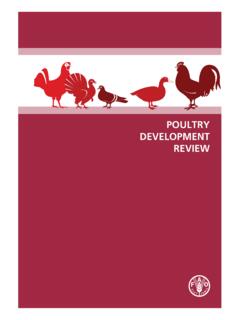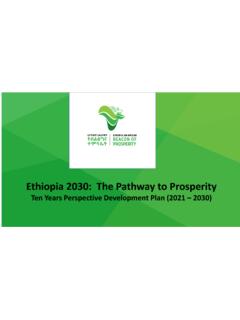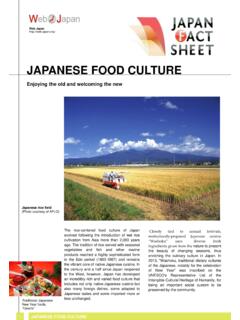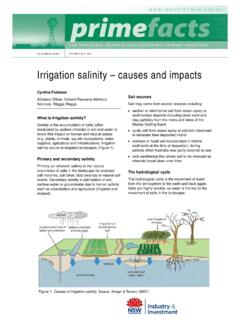Transcription of UNIT 2 RURAL DEVELOPMENT— CONCEPTS AND STRATEGIES
1 21 RURAL DevelopmentExperiences An AsianPerspectiveUNIT 2 RURAL DEVELOPMENT CONCEPTSAND of RURAL Development Projects and RURAL Level Participation in RURAL Development Development of RURAL Development Development Us Sum and Suggested Your Progress Possible going through this unit you should be able to: Describe the background in which RURAL development as a subject has gainedimportance; Identify the important CONCEPTS of RURAL development; Assess the importance of evolving RURAL development STRATEGIES ; Enumerate the different RURAL development STRATEGIES advocated by differentschools of thought; and Explain the importance of planning RURAL development subject of RURAL development has gained widespread appeal in recent years.
2 Thisis largely a result of the way issues regarding development themselves began to beperceived. In the preceding unit we discussed at some length issues relating toconcepts of development. As we saw, during the post-World War II era, developmenttheorists became increasingly dissatisfied with the way traditional CONCEPTS ofdevelopment emphasized growth and neglected important issues related to distributivejustice and other dimensions of development. The interest in RURAL development ispartly an offshoot of such a disenchantment and also on account of the growingrealization of the centrality of RURAL development in facilitating the process of overalldevelopment.
3 In this unit you will get a better feel of this BACKGROUNDR ural development became a planning concern as it became clear that the strategiesadopted in developing countries remained largely ineffective in alleviating poverty and22 RURAL Development Concept, STRATEGIES andExperiencesinequalities in RURAL areas. It became increasingly clear that apart from an effort toincrease agricultural and industrial production, it was also necessary to address directlythe problems of education, health services and employment and to attack the problemof poverty in RURAL area. The increasing interest in RURAL development is a resultof the realization that a systematic effort is necessary to create better livingconditions in the RURAL areas where the vast majority of populations of developingcountries the 1950s and 1960s, development policy makers sought to increase productivityand per capita incomes through advances in the manufacturing sector.
4 In the realmof agricultural production, growth in output during the first two decades afterindependence was achieved mainly by increasing the area under cultivation, supportedby expansion in public investment in supporting infrastructure. It was soon realized,however, that the gains from these methods reached, to a large extent, only a smallminority mainly those who were already better off and privileged. In fact, the gainsmade as a result of these efforts are believed to have further accentuated inequalityin incomes in RURAL areas. By the 1970s it became clear that there were seriousproblems in the way the issues and problems of development were being tackled.
5 Inparticular, the hope that the problems of unemployment and poverty in RURAL areaswould get addressed adequately was certainly not , in this Block, we will also examine in some detail the Green Revolutionstrategy to increase agricultural productivity in the country. We will see how thesemethods did not succeed in providing widespread gains. Most importantly, they did notbring about any significant changes in the conditions of the labouring classes in , it has been observed that industrialization and the advancement ofeconomies in western societies was linked to major economic changes in the ruralsociety.
6 You may be aware that the industrial revolution in England, as also in manyother countries in Europe, and the maturing of Japanese industry among others, wereall preceded by far reaching changes in agrarian societies. Land reforms and otherlegislative reforms were instrumental in bringing about a change in RURAL economiesin many of these countries. Industrial growth and modernization were accompaniedby increased productivity in the agricultural sector and urbanization. In many cases,access to colonies was a critical input in their economic advancement. Also, largemale migration from Europe was very helpful in relocating surplus labour.
7 For instance,it is well documented that over 40 million people emigrated from Europe during 1870to 1914 alone. As a result of all these factors these societies were able to reducepoverty and increase the role of non-agricultural activities in their the other hand, in large parts of the developing world, these conditions have notbeen brought about. The impact that RURAL development STRATEGIES can have in thesecountries, in the absence of those prerequisite changes, cannot be underestimated. Itis also clear that the patterns of economic transformation in developed countriescannot be replicated as the historical circumstances in the developing countries arequite different from those prevailing then in the former cases.
8 The upshot of all thisis that well formulated and clearly focused STRATEGIES of RURAL development are a mustin the developing OF RURAL DEVELOPMENTThe notion of RURAL development has been conceived in diverse ways by researchers,ranging from thinking of it as a set of goals and programmes to a well-knit strategy,approach or even an ideology. If you wade through the relevant literature, you willrealize that its scope and content are nebulous and do not have well-accepted analytical23 RURAL DevelopmentExperiences An AsianPerspectiveboundaries. As has often been noted, however, this may be viewed both as a weaknessas well as a strength.
9 A weakness because, apart from the issue conceptual clarity,it also means that the very operation of this idea is in a grey zone. A strength becausesuch a situation allows considerable flexibility for policy makers to take into accountdifferent ground be the differences in conceptualizing the notion of RURAL development, thereis a widely shared view that its essence should be poverty alleviation and distributivejustice oriented economic transformation. Given such a view, you may have thefollowing as primary objectives of RURAL )To improve the living standards by providing food, shelter, clothing, employmentand education;b)To increase productivity in RURAL areas and reduce poverty;c)To involve people in planning and development through their participation indecision making and through decentralization of administration.
10 D)To ensure distributive justice and equalization of opportunities in the the preceding unit on development, we saw that there is no single universallyacceptable approach towards development. We also saw that STRATEGIES are necessaryto progress towards development since it is a long-term process. Similarly, there arevarious approaches to the problem of RURAL development. Various schools of thoughtperceive the problem of RURAL development differently and emphasize different setsof factors in their Development Projects and ProgrammesIt is important to distinguish between RURAL development projects and development projects are micro level efforts to bring about change in ruralareas.







